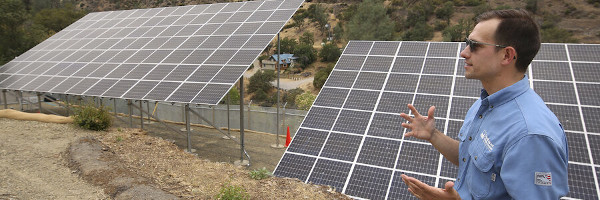Microgrids Sustainable resilient mobile power for disasters: Difference between revisions
No edit summary |
No edit summary |
||
| Line 2: | Line 2: | ||
| title = Mobi Microgrids: Sustainable, resilient, mobile power for today’s challenges and tomorrow’s disasters | | title = Mobi Microgrids: Sustainable, resilient, mobile power for today’s challenges and tomorrow’s disasters | ||
| team = FreeWire Technologies | | team = FreeWire Technologies, San Francisco Department of Emergency Management, The Salvation Army | ||
| leader = Torben Spitzer (FreeWire) | | leader = Torben Spitzer (FreeWire) | ||
| Line 9: | Line 9: | ||
| image = power-grid_standard.jpg | | image = power-grid_standard.jpg | ||
| imagecaption = Resilient Microgrid | | imagecaption = Resilient Microgrid | ||
| municipalities = San Francisco | | municipalities = San Francisco CA | ||
| status = Launched | | status = Launched | ||
| website = https://www.freewiretech.com/mobile-power/ | | website = https://www.freewiretech.com/mobile-power/ | ||
Revision as of 04:55, December 7, 2021
| Microgrids Sustainable resilient mobile power for disasters | |
|---|---|

| |
 Resilient Microgrid | |
| Team Organizations | FreeWire Technologies San Francisco Department of Emergency Management The Salvation Army |
| Team Leaders | Torben Spitzer (FreeWire) |
| Participating Municipalities | San Francisco CA |
| Status | Launched |
| Document | None |
Description
Deploy mobile, rechargeable power units throughout city departments to intelligently manage and measure energy usage. This can result in reduced energy costs through time shifting consumption from daytime to nighttime and peak shaving to lower demand charges. The mobile chargers would be remotely monitored and available to be deployed in the immediate aftermath of a catastrophe.
- FreeWire Technologies will demonstrate their capability to deploy and remotely monitor mobile chargers, while also delivering and quantifying energy savings.
- San Francisco Department of Emergency Management will demonstrate how mobile charging units will enhance response and recovery efforts in the wake of a catastrophe.
Challenges
The challenges this team are addressing are the lack of redundant power sources when traditional sources of power and energy are disrupted by a disaster and the need for building owners to measure and manage energy costs on a daily basis.
Solutions
The solution uses FreeWire's Mobi Gen to deliver power wherever and whenever it's needed, whether to a building or directly to devices in the case of an emergency.
Major Requirements
- Develop regional team with representatives from emergency management, general services, public works and transportation sectors.
- Create scope and requirements.
- Analyze energy usage profiles of buildings where Mobi Gens will be deployed.
- Demonstrate capabilities during the Urban Shield/Yellow Command and/or Fleet Week in Fall of 2016.
- Demonstrate capabilities during Cal OES’s capstone exercise in 2017.
Performance Targets
| Key Performance Indicators (KPIs) | Measurement Methods |
|---|---|
|
|
Standards, Replicability, Scalability, and Sustainability
- Mobi Gens are designed to be drop-in replacements for traditional generators, sharing the same types of outlets and workflow.
- FreeWire's cloud platform will be capable of receiving demand response signals via the OpenADR protocol.
- FreeWire's cloud platform has APIs to share data and functionality across other applications.
- Scalability and replicability are inherent to this project. Mobi Gens are designed as discrete mobile units, but can aggregated to deliver additional power and runtimes. The project would be deployed at multiple locations, each with a similar setup. Sustainability is also integral to FreeWire's business, both environmentally and in terms of longevity. FreeWire uses second-life (repurposed) lithium-ion batteries removed from electric vehicles to power its Mobis, thus saving them from being disposed as toxic waste. Longevity is ensured through energy savings: the economics would be harder to justify if Mobi Gens were only used as disaster recovery, so capturing energy savings helps offset the cost.
Cybersecurity and Privacy
Impacts
This project will provide a major benefit in preparing for and recovering from a catastrophic earthquake by having mobile power sources on call all around the city. Other benefits include new jobs (all Mobis are built locally in the SF Bay Area), better air quality by mitigating diesel generator emissions, more effective use of taxpayer dollars by spending less on building energy, reduced noise pollution (Mobi Gens are completely quiet), and a more stable electrical grid by smoothing out demand.
Demonstration/Deployment
- Phase I Pilot/Demonstration:
Demonstrate how a network of mobile charging units can be quickly deployed in the aftermath of a catastrophic earthquake.
- Phase II Deployment:
Deploy network of mobile charging units and perform exercises that demonstrate how they would be deployed for recovery purposes. Between exercises the charging units would be connected to their respective buildings and performing energy management services like time-of-use rate arbitrage, peak shaving, and demand response to reduce energy costs.